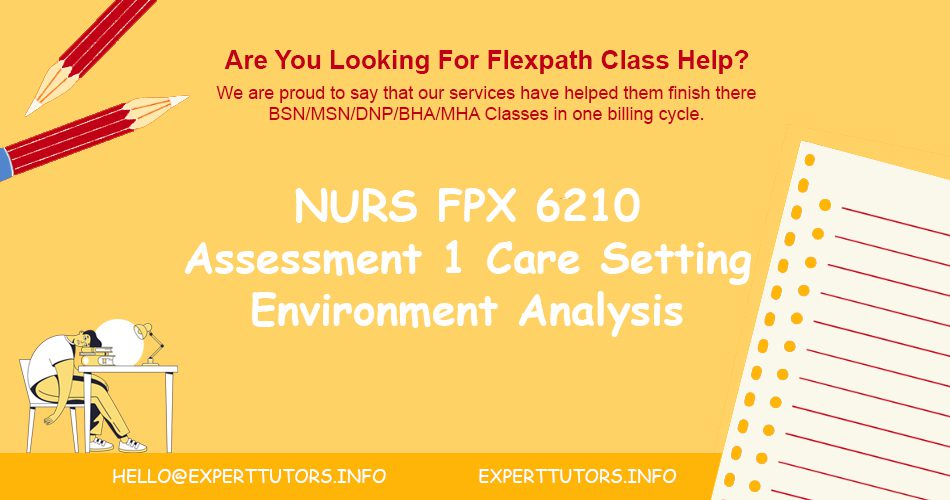Assessment 01: Care Setting Environment Analysis
Name
Capella University
NURS-FPX 6210
Prof. Name
April 29, 2024
Care Setting Environment Analysis
As a nurse leader at City Hospital, understanding the dynamic healthcare environment is crucial for maintaining a competitive edge and enhancing the quality and safety of care. Employing analytical methods like Appreciative Inquiry (AI) and SWOT analysis, I aim to pinpoint potential areas for improvement and formulate a strategic action plan. AI focuses on leveraging the positive attributes of our environment and envisioning an optimal future. At the same time, SWOT analysis identifies internal and external challenges and opportunities, enabling us to devise effective strategies that capitalize on our strengths, mitigate weaknesses, and optimize our response to threats and opportunities (Lee et al., 2021). This integrated approach ensures that our efforts are impactful, benefiting both our patients and the broader community.
Part 1: Appreciative Inquiry Discovery and Dream
Evidence Related to the Best Performance of Care Settings
City Hospital has demonstrated its commitment to quality and safety through several successful initiatives. For example, significant reductions in hospital-acquired infections were achieved by adhering to evidence-based practices, such as rigorous hand hygiene protocols, and fostering a safety-first culture that prioritizes infection prevention. This approach not only enhanced patient safety but also showed effectiveness in implementing critical health measures. The adoption of a patient-centered care model, tailored to the individual needs and preferences of patients, led to higher satisfaction and better clinical outcomes, including lower rates of readmission. While these achievements mark significant progress, areas for further investigation remain, such as sustaining these improvements long-term and extending the patient-centered approach across other hospital departments. Addressing the broader social determinants of health that influence patient outcomes continues to be an essential focus for ongoing research and development.
SMART Goals for the Care Setting
The care setting has outlined several goals aimed at enhancing quality and safety. First, to improve interactions between healthcare providers and patients, the plan is to increase both the frequency and effectiveness of communication through targeted communication skills training for providers. Secondly, the introduction of a thorough infection prevention and control strategy is planned, which will utilize data analytics to detect trends and potential risks to patient safety. Finally, to better meet the diverse needs of various patient groups, continuous training in cultural competence will be provided to healthcare staff, ensuring they are equipped to understand and cater to the unique preferences and requirements of different populations (Ghosh et al., 2022)
Achieving safety improvement goals is fundamentally transformative, propelling organizations like City Hospital towards enhanced safety and quality, while considering the needs of its employees. Training healthcare providers in advanced communication skills will facilitate the development of trust and rapport with patients, enhance patients’ comprehension of their treatments, and encourage mutual decision-making. Bolstering cultural competence is essential to ensure that the healthcare delivered is respectful of and aligned with patients’ cultural beliefs and values, thereby upholding dignity and respect in patient care (Midgley et al., 2023). The set goals resonate with City Hospital’s mission, vision, and values, which emphasize high-quality, patient-centric care that is compassionate and culturally sensitive. These goals presume that targeted communication training and comprehensive infection control can elevate patient safety and outcomes and that increasing cultural competence is vital for equitable care. Fulfilling these objectives will enable City Hospital to more effectively meet its mission and cater to the diverse needs and preferences of its patient base.
Part 2: SWOT Analysis
Strengths:
- The healthcare providers are highly skilled and possess extensive experience.
- There exists a pronounced commitment to safety and ongoing quality enhancements.
- The facility benefits from a sophisticated electronic health record system.
- It has access to cutting-edge medical technologies and equipment.
Weaknesses:
- Staffing shortages contribute to increased workloads and employee burnout.
- Communication and collaboration among healthcare providers are often uneven.
- There is a lack of adequate patient education and involvement.
- Resources dedicated to infection prevention and control are insufficient.
Opportunities:
- There are possibilities for expanding programs that increase patient education and involvement.
- Integrating data analytics could significantly improve quality improvement efforts.
- Partnering with community organizations could help address social determinants impacting health.
- There is potential for implementing proven infection prevention and control methods.
Threats:
- There is a growing complexity in regulatory demands and compliance obligations.
- Competition is intensifying with other medical providers in the area.
- Changes in reimbursement frameworks and financial models could impact funding.
- The risk of emerging infectious diseases and drug-resistant organisms continues to rise.
Relationships to Quality and Safety Goals
The SWOT analysis has highlighted several key areas for potential improvement in quality and safety at City Hospital. The hospital’s strengths, including its competent healthcare professionals and a robust culture of safety, offer a solid foundation to tackle existing weaknesses like the shortage of staff and sporadic communication. The opportunities identified, such as enhancing patient education and engagement initiatives and adopting proven infection prevention and control measures, could counteract threats like escalating regulatory demands and rising competition from nearby healthcare facilities (Ottonello et al., 2023). This analysis serves as a blueprint for City Hospital to formulate a strategic plan that effectively utilizes its strengths, remedies weaknesses, seizes opportunities, and diminishes threats to fulfill its objectives related to quality and safety.
The Area of Concern Identified In a SWOT Analysis
In the SWOT analysis conducted for City Hospital, one significant area of concern that emerged is the insufficient staffing levels, which have led to increased workloads and staff burnout. This issue is critically aligned with the hospital’s mission, vision, and values emphasizing delivering high-quality, compassionate care to all patients. To assess any improvements made in addressing this concern, several criteria could be utilized, including staffing ratios, staff satisfaction, patient satisfaction, and overall quality of care. These metrics can be evaluated using both quantitative and qualitative data sources, such as surveys from staff and patients, and by monitoring changes in these indicators over time to gauge the success of initiatives aimed at enhancing staffing conditions (Rowe & Knox, 2023).
Part 3: Comparison of Approaches
The comparison between Appreciative Inquiry (AI) and SWOT analysis reveals distinct approaches to data collection and stakeholder interaction. AI focuses on positive experiences, utilizing interviews and focus groups to gather qualitative data highlighting organizational strengths and successes. This method demands substantial stakeholder engagement and is aimed at cultivating a positive organizational culture through relationship-building. In contrast, SWOT analysis employs a more quantitative method, using surveys and metrics to identify strengths, weaknesses, opportunities, and threats, providing a broad, objective view of the organizational landscape. While AI encourages collaborative dialogue to forge a collective vision and foster support for changes, SWOT tends to gather individual perspectives, which might not as effectively generate consensus or a shared vision (Arundell et al., 2021). Each approach carries inherent assumptions and biases: AI values positive inputs over negative ones, while SWOT prioritizes objective data over subjective viewpoints. Recognizing these biases is crucial when choosing an analysis method, as it influences the interpretation and outcomes of the analysis, ensuring a more comprehensive and meaningful evaluation.
Part 4: Analysis of Relevant Leadership Characteristics and Skills
The AI and SWOT analytical methods underscore different yet critical leadership characteristics and skills necessary for effective management. For the AI method, leaders need to excel in fostering an atmosphere of positive communication where team members feel safe to share their successes and ideas. Such leaders typically exhibit high emotional intelligence, celebrating team strengths and expertly facilitating group discussions to align the team with their goals. Conversely, the SWOT method demands a leader adept at evaluating the strengths and weaknesses within the team and the broader organization (Armstrong et al., 2020). These leaders must pinpoint areas needing enhancement, devise strategic plans for improvement, and adeptly analyze data to make informed, evidence-based decisions.
Despite these insights, uncertainties and gaps in knowledge persist regarding the optimal leadership traits for performance improvement initiatives in healthcare. Questions remain about the relative importance of specific leadership characteristics versus experience and qualifications (Al Alawi et al., 2020). The influence of an organization’s unique culture and values on the desired leadership traits is not fully understood. More research is necessary to elucidate the most effective leadership styles and skills for advancing performance improvement in healthcare environments.
NURS FPX 6210 Assessment 1 Care Setting Environment Analysis Conclusion :
In conclusion, City Hospital’s SWOT analysis has provided valuable insights into the current strengths, weaknesses, opportunities, and threats facing the institution. Leveraging its highly skilled workforce and strong safety culture, the hospital has the potential to address areas needing improvement, such as staffing shortages and patient engagement. By capitalizing on opportunities for advancing patient education and integrating data analytics into quality initiatives, City Hospital can mitigate external threats like increasing competition and regulatory challenges. The comparison between AI and SWOT methodologies highlights the importance of choosing the right approach to leadership and analysis to drive change and achieve long-term quality and safety goals effectively (Teoli et al., 2023).
NURS FPX 6210 Assessment 1 Care Setting Environment Analysis References :
Al Alawi, L., Soteriades, E. S., Paulo, M. S., Östlundh, L., Grivna, M., Al Maskari, F., & Al-Rifai, R. H. (2020). Environmental assessment of cytotoxic drugs in healthcare settings: protocol for a systematic review and meta-analysis. Systematic Reviews, 9(1), 242. https://doi.org/10.1186/s13643-020-01494-4
Armstrong, A. J., Holmes, C. M., & Henning, D. (2020). A changing world, again. How Appreciative Inquiry can guide our growth. Social Sciences & Humanities Open, 2(1), 100038. https://doi.org/10.1016/j.ssaho.2020.100038
Arundell, F., Sheehan, A., & Peters, K. (2021). Developing and conducting appreciative inquiry interviews. Nurse Researcher, 29(4), 36–43. https://doi.org/10.7748/nr.2021.e1811
Farrington, N., Dantanus, K., Richardson, A., & Bridges, J. (2023). Understanding the cultural environment of the outpatient care setting for patients with dementia receiving cancer treatment: A qualitative study. Health Expectations, 26(1), 98–107. https://doi.org/10.1111/hex.13523
Ghosh, S., Struminger, B. B., Singla, N., Roth, B. M., Kumar, A., Anand, S., Mtete, E., Lusekelo, J., Massawe, I., Jarpe-Ratner, E., Seweryn, S. M., Risley, K., Moonan, P. K., & Pinsker, E. (2022). Appreciative inquiry and the co-creation of an evaluation framework for Extension for Community Healthcare Outcomes (ECHO) implementation: a two-country experience. Evaluation and Program Planning, 92, 102067. https://doi.org/10.1016/j.evalprogplan.2022.102067
Irani, E., Hirschman, K. B., Cacchione, P. Z., & Bowles, K. H. (2020). The role of social, economic, and physical environmental Factors in care planning for home health care recipients. Research in Gerontological Nursing, 13(3), 130–137. https://doi.org/10.3928/19404921-20191210-01
Lee, S. Y., Hung, L., Chaudhury, H., & Morelli, A. (2021). Staff perspectives on the role of physical environment in long-term care facilities on dementia care in Canada and Sweden. Dementia, 20(7), 2558–2572. https://doi.org/10.1177/14713012211003994
Midgley, W., Mizen, A., Bailey, R., Hollinghurst, J., Hollinghurst, R., Lyons, R. A., Pedrick-Case, R., & Fry, R. (2023). How does the environment in and around the home affect social care and health outcomes for older people? A national longitudinal dynamic cohort study. Lancet, 402 Suppl 1, S69. https://doi.org/10.1016/S0140-6736(23)02096-2
Merriel, A., Wilson, A., Decker, E., Hussein, J., Larkin, M., Barnard, K., O’Dair, M., Costello, A., Malata, A., & Coomarasamy, A. (2022). Systematic review and narrative synthesis of the impact of Appreciative Inquiry in healthcare. BMJ Open Quality, 11(2), e001911. https://doi.org/10.1136/bmjoq-2022-001911
Ottonello, G., Napolitano, F., Musio Maria, E., Catania, G., Zanini, M., Aleo, G., Timmins, F., Sasso, L., & Bagnasco, A. (2023). Fundamental care: An evolutionary concept analysis. Journal of Advanced Nursing, 79(6), 2070–2080. https://doi.org/10.1111/jan.15451
Rowe, A., & Knox, M. (2023). The impact of the healthcare environment on patient experience in the emergency department: A systematic review to understand the implications for Patient-Centered Design. HERD, 16(2), 310–329. https://doi.org/10.1177/19375867221137097
Teoli, D., Sanvictores, T., & An, J. (2023). SWOT Analysis. In StatPearls. StatPearls Publishing.




